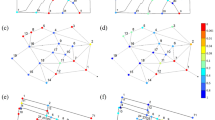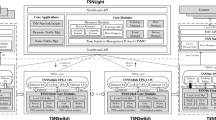Abstract
In many real-time networks such as computer networks, each arc has stochastic capacity, lead time, and accuracy rate. Such a network is named a multi-state computer network (MSCN). Under the strict assumption that the capacity of each arc is deterministic, the quickest path (QP) problem is to find a path that sends a specific amount of data with minimum transmission time. From the viewpoint of internet quality, the transmission accuracy rate is one of critical performance indicators to assess internet network for system administrators and customers. Under both assured accuracy rate and time constraint, this paper extends the QP problem to discuss the flow assignment for a MSCN. An efficient algorithm is proposed to find the minimal capacity vector meeting such requirements. The system reliability, the probability to send \(d\) units of data through multiple minimal paths under both assured accuracy rate and time constraint, can subsequently be computed. Furthermore, two routing schemes with spare minimal paths are adopted to reinforce the system reliability. The enhanced system reliability according to the routing scheme is calculated as well. The computational complexity in both the worst case and average case are analyzed.


Similar content being viewed by others
References
Al-Ghanim, A. M. (1999). A heuristic technique for generating minimal paths and cutsets of a general network. Computers & Industrial Engineering, 36, 45–55.
Amer, P. D. (1982). A measurement center for the NBS local area computer network. IEEE Transactions on Computers, 31, 723–729.
Aven, T. (1985). Reliability evaluation of multistate systems with multistate components. IEEE Transactions on Reliability, 34, 473–479.
Brecht, T. B., & Colbourn, C. J. (1988). Lower bounds on two-terminal network reliability. Discrete Applied Mathematics, 21, 85–198.
Chen, Y. L., & Chin, Y. H. (1990). The quickest path problem. Computers & Operations Research, 17, 153–161.
Cheng, S. T. (1998). Topological optimization of a reliable communication network. IEEE Transactions on Reliability, 47, 225–233.
Chlamtac, I. (1980). Issues in design and measurement of local area networking. In Proceedings of Computer Measurement Group Conference CMG XI (pp. 32–34).
Ford, L. R., & Fulkerson, D. R. (1962). Flows in networks. Princeton, NJ: Princeton University Press.
Hui, K.-P., Bean, N., & Kraetzl, M. (2005). The cross-entropy method for network reliability estimation. Annals of Operations Research, 134, 101–118.
Hung, Y. C., & Chen, G. H. (1992). Distributed algorithms for the quickest path problem. Parallel Computing, 18, 823–834.
Jain, R., & Routhier, S. A. (1986). Packet trains: Measurements and a new model for computer network traffic. IEEE Journal on Selected Areas in Communications, 4, 986–995.
Jane, C. C., Lin, J. S., & Yuan, J. (1993). On reliability evaluation of a limited-flow network in terms of minimal cutsets. IEEE Transactions on Reliability, 42, 354–361.
Kim, W. K., Yoon, P. K., Kim, Y., & Bronson, G. J. (2012). Improving system performance for stochastic activity network: A simulation approach. Computers and Industrial Engineering, 62, 1–12.
Kobayashi, K., & Yamamoto, H. (1999). A new algorithm in enumerating all minimal paths in a sparse network. Reliability Engineering & System Safety, 65, 11–15.
Levitin, G., & Lisnianski, A. (2001). A new approach to solving problems of multi-state system reliability optimization. Quality and Reliability Engineering International, 17, 93–104.
Lin, J. S., Jane, C. C., & Yuan, J. (1995). On reliability evaluation of a capacitated-flow network in terms of minimal pathsets. Networks, 25, 131–138.
Lin, Y. K. (2003). Extend the quickest path problem to the system reliability evaluation for a stochastic-flow network. Computers & Operations Research, 30, 567–575.
Lin, Y. K. (2007). On a multicommodity stochastic-flow network with unreliable nodes subject to budget constraint. European Journal of Operational Research, 176, 347–360.
Lin, Y. K. (2009). Time version of the shortest path problem in a stochastic-flow network. Journal of Computational and Applied Mathematics, 228, 150–157.
Lin, Y. K. (2010). System reliability of a stochastic-flow network through two minimal paths under time threshold. International Journal of Production Economics, 124, 382–387.
Lin, Y. K. (2011). Transmission reliability of k minimal paths within time threshold. Computers and Industrial Engineering, 61, 1160–1165.
Mäder, A., & Staehle, D. (2009). Radio resource management for the UMTS enhanced uplink in presence of QoS radio bearers. Annals of Operations Research, 170, 183–197.
Martins, E. D. Q. V., & Santos, J. L. E. D. (1997). An algorithm for the quickest path problem. Operations Research Letters, 20, 195–198.
Mori, T., Takine, T., Pan, J., Kawahara, R., Uchida, M., & Goto, S. (2007). Identifying heavy-hitter flows from sampled flow statistics. IEICE Transactions on Communications, 90, 3061–3072.
Park, C. K., Lee, S., & Park, S. (2004). A label-setting algorithm for finding a quickest path. Computers & Operations Research, 31, 2405–2418.
Ramirez-Marquez, J. E., & Coit, D. W. (2005). A Monte-Carlo simulation approach for approximating multi-terminal reliability. Reliability Engineering & System Safety, 87, 253–264.
Shen, Y. (1995). A new simple algorithm for enumerating all minimal paths and cuts of a graph. Microelectronics and Reliability, 35, 973–976.
Xue, J. (1985). On multistate system analysis. IEEE Transactions on Reliability, 34, 329–337.
Yeh, W. C. (2002). Search for minimal paths in modified networks. Reliability Engineering & System Safety, 75, 389–395.
Yeh, W. C. (2004). Multistate network reliability evaluation under the maintenance cost constraints. International Journal of Production Economics, 88, 73–83.
Yeh, W. C. (2005). A new approach to evaluating reliability of multistate networks under the cost constraint. Omega, 33, 203–209.
Yeh, W. C. (2008). A simple minimal path method for estimating the weighted multi-commodity multistate unreliable networks reliability. Reliability Engineering & System Safety, 93, 125–136.
Zuo, M. J., Tian, Z., & Huang, H. Z. (2007). An efficient method for reliability evaluation of multistate networks given all minimal path vectors. IIE Transactions, 39, 811–817.
Author information
Authors and Affiliations
Corresponding author
Rights and permissions
About this article
Cite this article
Lin, YK., Huang, CF. Reliability evaluation according to a routing scheme for multi-state computer networks under assured accuracy rate. Ann Oper Res 244, 221–240 (2016). https://doi.org/10.1007/s10479-014-1673-8
Published:
Issue Date:
DOI: https://doi.org/10.1007/s10479-014-1673-8




